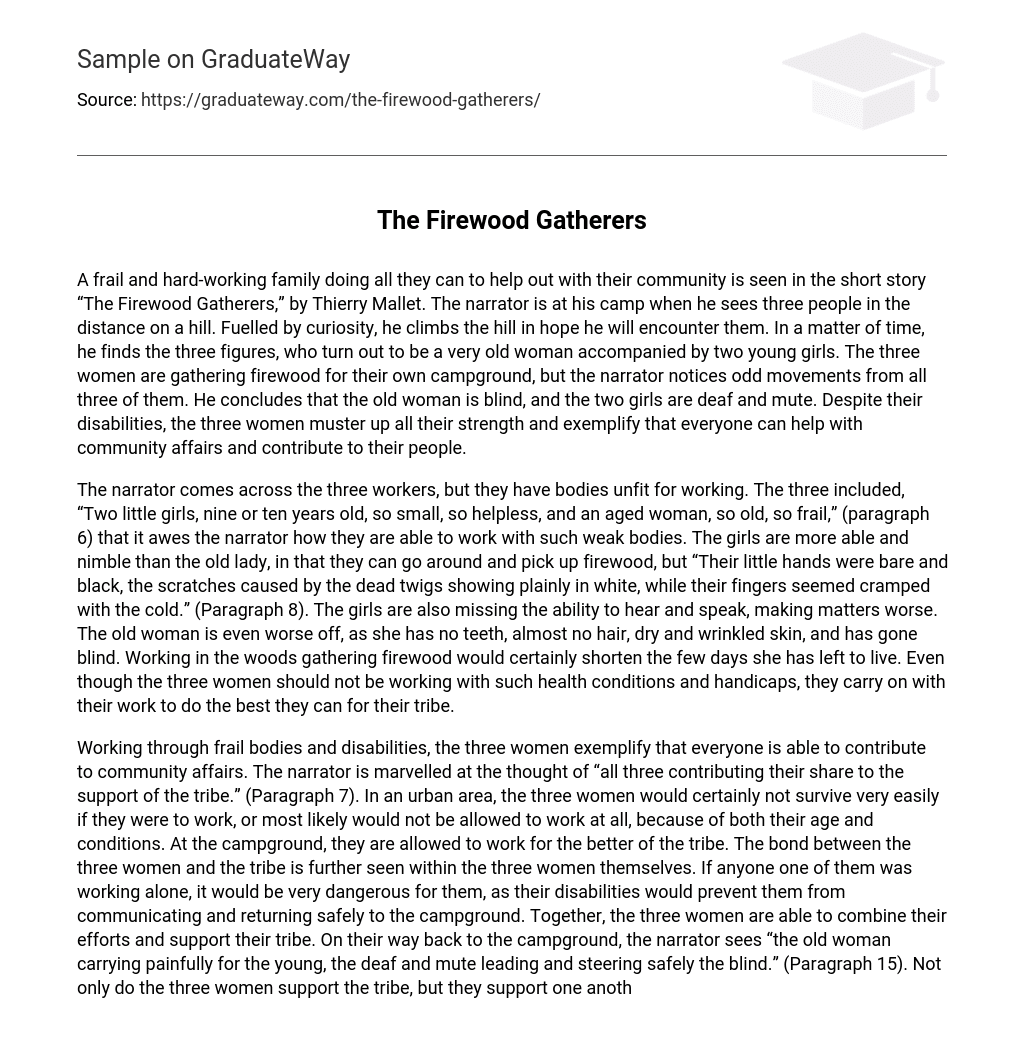A frail and hard-working family doing all they can to help out with their community is seen in the short story “The Firewood Gatherers,” by Thierry Mallet. The narrator is at his camp when he sees three people in the distance on a hill. Fuelled by curiosity, he climbs the hill in hope he will encounter them. In a matter of time, he finds the three figures, who turn out to be a very old woman accompanied by two young girls. The three women are gathering firewood for their own campground, but the narrator notices odd movements from all three of them. He concludes that the old woman is blind, and the two girls are deaf and mute. Despite their disabilities, the three women muster up all their strength and exemplify that everyone can help with community affairs and contribute to their people.
The narrator comes across the three workers, but they have bodies unfit for working. The three included, “Two little girls, nine or ten years old, so small, so helpless, and an aged woman, so old, so frail,” (paragraph 6) that it awes the narrator how they are able to work with such weak bodies. The girls are more able and nimble than the old lady, in that they can go around and pick up firewood, but “Their little hands were bare and black, the scratches caused by the dead twigs showing plainly in white, while their fingers seemed cramped with the cold.” (Paragraph 8). The girls are also missing the ability to hear and speak, making matters worse. The old woman is even worse off, as she has no teeth, almost no hair, dry and wrinkled skin, and has gone blind. Working in the woods gathering firewood would certainly shorten the few days she has left to live. Even though the three women should not be working with such health conditions and handicaps, they carry on with their work to do the best they can for their tribe.
Working through frail bodies and disabilities, the three women exemplify that everyone is able to contribute to community affairs. The narrator is marvelled at the thought of “all three contributing their share to the support of the tribe.” (Paragraph 7). In an urban area, the three women would certainly not survive very easily if they were to work, or most likely would not be allowed to work at all, because of both their age and conditions. At the campground, they are allowed to work for the better of the tribe. The bond between the three women and the tribe is further seen within the three women themselves. If anyone one of them was working alone, it would be very dangerous for them, as their disabilities would prevent them from communicating and returning safely to the campground. Together, the three women are able to combine their efforts and support their tribe. On their way back to the campground, the narrator sees “the old woman carrying painfully for the young, the deaf and mute leading and steering safely the blind.” (Paragraph 15). Not only do the three women support the tribe, but they support one another.
Much is to be admired from these three women. They do not let their weakness get the better of them and prevent them from being useless figures. More so, they overcome their disabilities and carry on working. It is unknown whether they are being forced to work, or whether they want to do what they can and show to the rest of the world that they are not as useless as they seem. The bonds between each of them are also to be admired, as they do not leave each other behind and take great care for one another. They also show that no matter what a person has or are, they should not be cast aside from the rest of the world. They should be treated as a normal human being and should be respected greatly.





